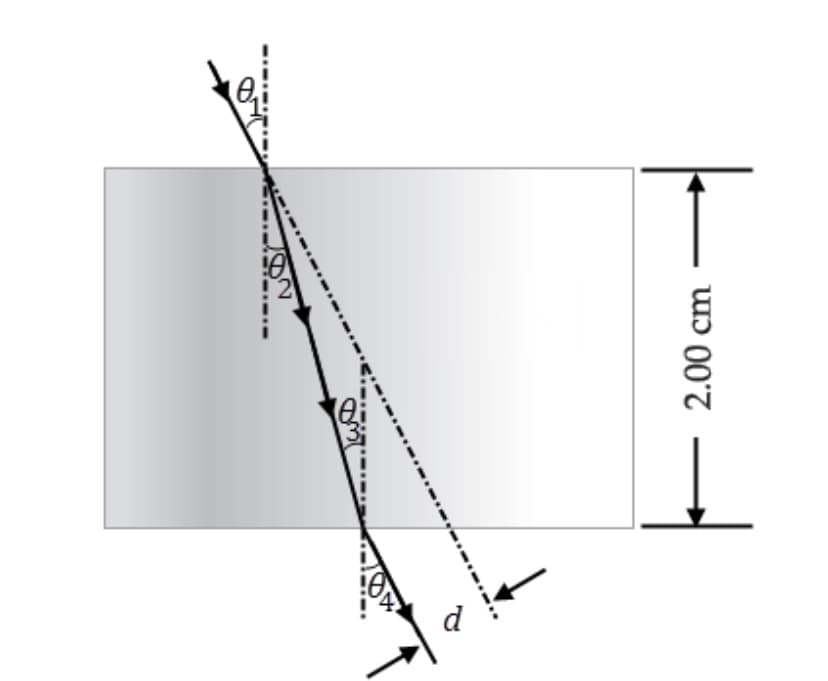ray of light strikes a flat glass block at an incidence angle of ?1 = 34.4°. The glass is 2.00 cm thick and has an index of refraction that equals ng = 1.20. A light ray incident on a glass block of thickness 2.00 cm is shown. The ray travels down and to the right and is incident to the top of the block at an angle ?1 to the normal of the surface. The ray inside the block moves down and to the right but at a steeper slope than the incident ray, making an angle of ?2 with the vertical. It is incident on the bottom surface of the block, making an angle of ?3 with the vertical, and exits moving down and to the right, at a less steep slope, making an angle of ?4 with the vertical. A dashed line extends from the original path of the ray down in the block and is shown to be a distance d from the ray that exits the glass block.
ray of light strikes a flat glass block at an incidence angle of ?1 = 34.4°. The glass is 2.00 cm thick and has an index of refraction that equals ng = 1.20. A light ray incident on a glass block of thickness 2.00 cm is shown. The ray travels down and to the right and is incident to the top of the block at an angle ?1 to the normal of the surface. The ray inside the block moves down and to the right but at a steeper slope than the incident ray, making an angle of ?2 with the vertical. It is incident on the bottom surface of the block, making an angle of ?3 with the vertical, and exits moving down and to the right, at a less steep slope, making an angle of ?4 with the vertical. A dashed line extends from the original path of the ray down in the block and is shown to be a distance d from the ray that exits the glass block.
College Physics
1st Edition
ISBN:9781938168000
Author:Paul Peter Urone, Roger Hinrichs
Publisher:Paul Peter Urone, Roger Hinrichs
Chapter1: Introduction: The Nature Of Science And Physics
Section: Chapter Questions
Problem 22PE: What is the area of a circle 3.102 cm in diameter?
Related questions
Question
A ray of light strikes a flat glass block at an incidence angle of
?1 = 34.4°.
The glass is 2.00 cm thick and has an index of refraction that equals
ng = 1.20.
A light ray incident on a glass block of thickness 2.00 cm is shown. The ray travels down and to the right and is incident to the top of the block at an angle ?1 to the normal of the surface. The ray inside the block moves down and to the right but at a steeper slope than the incident ray, making an angle of ?2 with the vertical. It is incident on the bottom surface of the block, making an angle of ?3 with the vertical, and exits moving down and to the right, at a less steep slope, making an angle of ?4 with the vertical. A dashed line extends from the original path of the ray down in the block and is shown to be a distance d from the ray that exits the glass block.
(a)
What is the angle of refraction,
?2,
that describes the light ray after it enters the glass from above? (Enter your answer in degrees to at least 2 decimal places.)
Answer in degrees °
(b)
With what angle of incidence,
?3,
does the ray approach the interface at the bottom of the glass? (Enter your answer in degrees to at least 2 decimal places.)
Answer in degrees °
(c)
With what angle of refraction,
?4,
does the ray emerge from the bottom of the glass? (Enter your answer in degrees to at least 1 decimal place.)
Answers in °
(d)
The distance d separates the twice-bent ray from the path it would have taken without the glass in the way. What is this distance (in cm)?
Answer in cm
(e)
At what speed (in m/s) does the light travel within the glass?
Answer in m/s
(f)
How many nanoseconds does the light take to pass through the glass along the angled path shown here?
Answer in ns

Transcribed Image Text:d
2.00 cm
Expert Solution
This question has been solved!
Explore an expertly crafted, step-by-step solution for a thorough understanding of key concepts.
This is a popular solution!
Trending now
This is a popular solution!
Step by step
Solved in 2 steps with 1 images

Knowledge Booster
Learn more about
Need a deep-dive on the concept behind this application? Look no further. Learn more about this topic, physics and related others by exploring similar questions and additional content below.Recommended textbooks for you

College Physics
Physics
ISBN:
9781938168000
Author:
Paul Peter Urone, Roger Hinrichs
Publisher:
OpenStax College


College Physics
Physics
ISBN:
9781938168000
Author:
Paul Peter Urone, Roger Hinrichs
Publisher:
OpenStax College
